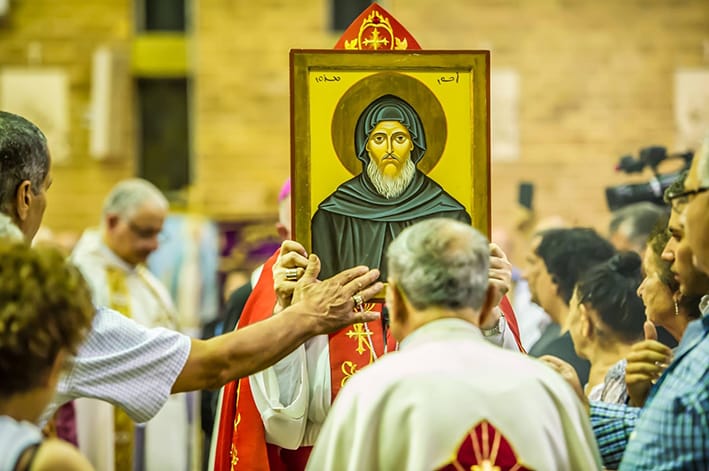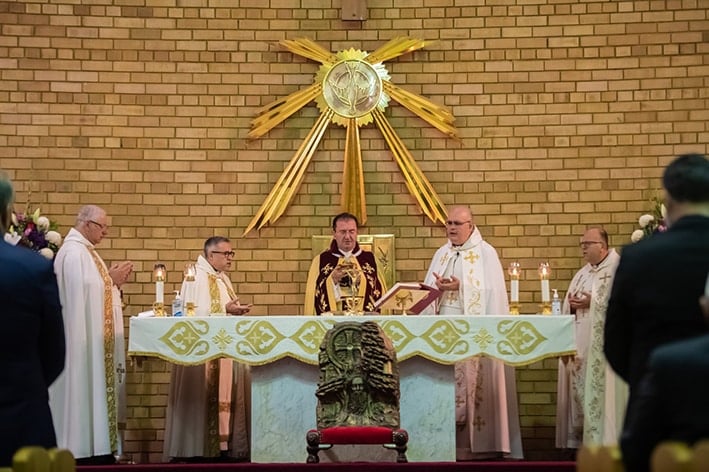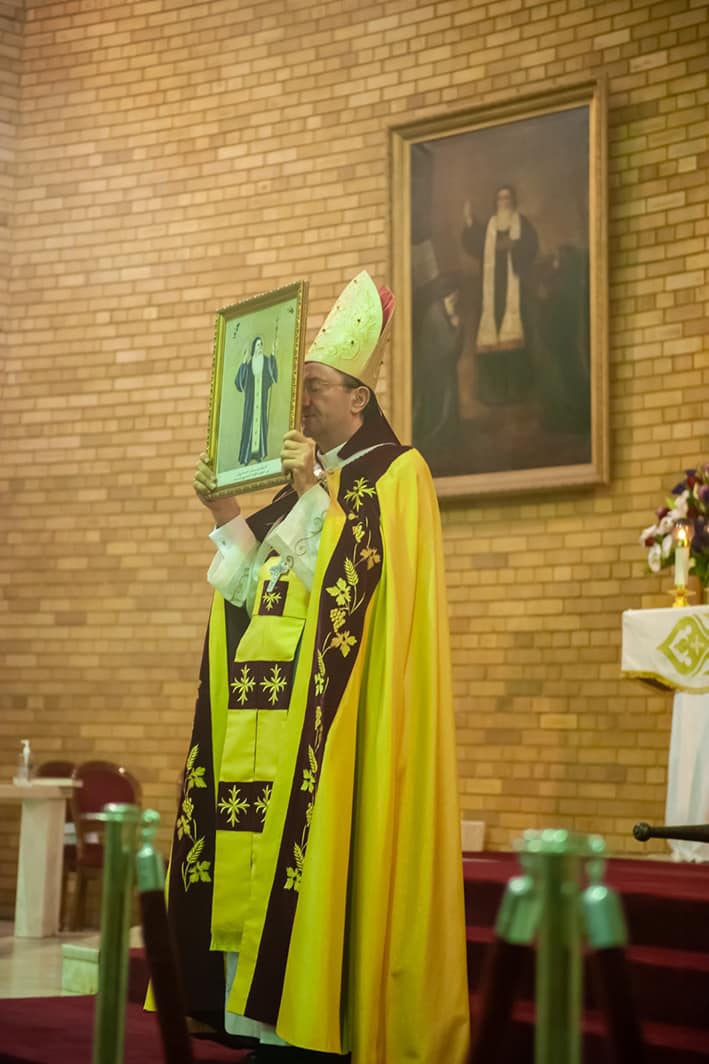
In an uncertain time, one saint pointed to Jesus with his whole life. From his witness, a church grew
Each year on 9 February, Maronite Catholics celebrate the Feast of their patron saint, St Maroun. His Feast in our world today continues to provide us with a source of hope; the more we learn about the testimony and life of this great saint, the more we can understand and live in hope, in the face of challenges and difficulties, and the more we can seek to bring everyone to Christ just like he did.
The world in which St Maroun lived was a difficult one, to say the least. In the fourth and the fifth centuries, not many had any security in life, and that was regardless of their social standing, spirituality or wealth. There were food supply shortages and diseases were rampant and – especially in the cities – law and order were failing and the Roman Empire was forever fighting against the many enemies who were invading it.
This brought about a population shift, with large numbers of people fleeing to the countryside to find peace, despite the hardships of living life on the land.
Maroun, a priest at the time, chose to leave a settled life for one of solitude, as a hermit living in the open air on a mountain top in Syria. He is known for converting a pagan temple into a church, erecting a small hut made of skins so he could pray and teach.
He chose a life of celibacy and poverty so that he could have spiritual children, and wealth of the spirit. He accepted all weather, the heat and the cold, rain and drought, to show that although the seasons changed, his soul and his will did not – he remained steadfast. As a hurricane does not blow down a mountain, so the winds did not shake Maroun from his mission.
And so it was that, remaining in one place, he drew men and women who came to him seeking spiritual advice and his way of life: chastity, prayer and meditation, and most importantly love. Maroun was passionate about spreading the message of the Lord and zealous about the healing of ‘lost souls’, also praying the Lord to heal the infirmities of the body.

Through his examples these men and women were reminded that their every action, their every thought, and their every feeling, was seen and weighed by God. Then, when they had learnt how to walk the path toward eternal life – detached from the physical and material world – they returned to their homes, where many founded monasteries and convents, hermitages and churches, and brought Christianity to the populations of the region, mainly to Syria and Lebanon.
After Maroun’s death around 410AD, a great monastery was built in the year 452AD and it was called Beit Maroun, or the “House of Maroun”. The people who converted and believed in the Gospel with the Monks of St Maroun’s Monastery were called Maronites. The Syriac-speaking peasants who had followed in the footsteps of St Maroun and his monastic spirituality became the pioneers of a new Church, the Maronite Antiochian Church, which was established in the 6th Century.
Today, the example of St Maroun is of inestimable value. We can read the Gospel of the day, then look at the life of St Maroun, and say: yes, this is what it means to serve rather than desire to be served. To not be concerned for personal ease or convenience, but rather, direct all our thoughts and all our heart to God, and to help our brothers and sisters through action and example. If we think of God, if we are reminded of Him in all things, then our mind and our heart are changed: for the soul becomes like the things it gazes upon.
It is an opportunity to preserve and spread our Maronite values, applying them in pastoral and charitable ways to the challenges of our day.” – Bishop Antoine-Charbel Tarabay
Year of Hope: emerging from the pandemic
Perhaps today, more than at any other time in our history here in Australia, we see, as a Maronite Catholic Church that we need to be a more Christ-like Church, we need the faith of St Maroun and his unwavering hope and courage in the face of challenges of his time and era.
This is the key to my Pastoral Plan for this year in our Maronite Catholic Church. In consultation with our Diocesan Pastoral Council we have chosen this year to be the Year of Hope.
It is with a steadfast hope that we start the journey of emergence from the pandemic, to recover from the sense of futility that seemed to settle upon us and rather, to reinstate trust and to open wide the doors of optimism that will lead us to rebuild new living connections where once there was separation and isolation.
Our roadmap includes a review of our pastoral leadership to continue to better prepare our parishes and communities in the face of challenges and in helping protect those at risk, to re-ignite pastoral activities in parishes, particularly online faith formation programs, and addressing the physical, material and spiritual impacts of the Pandemic on individuals, families, clergy (priests and nuns) and community.
If we meditate upon it, we see that our times are far more similar to those during which St Maroun lived than we would have guessed. Therefore our meditation must lead us to deepen our faith and spirituality in order to live our mission in today’s world.

Plenary council
Last year, our pilgrimage with the Australian Catholic Church in discerning and listening to what the Holy Spirit is saying to all of us culminated in the Plenary Council. And although the future is never certain, we have great signs of hope for the Catholic Church in Australia. The Plenary is a unique occasion for us as Catholics, practising in the Latin church or in the Eastern churches, to come together for the spiritual renewal and conversion of this land.
It is known that prayers are like oxygen for the life of the believers, and, for plenaries and synods, it plays a key role in our journey together united in our love to the Lord. It is imperative we all continue to accompany the Plenary with our prayers for fruitful outcome, especially during the second session to be held in Sydney in July 2022.
Now it remains only to walk the line between faithfulness and openness, not only here in Australia, but also to carry the church’s mission to all the countries of Oceania. It is an opportunity to preserve and spread our Maronite values, applying them in pastoral and charitable ways to the challenges of our day. This is where we can learn from the life of St Maroun, our spiritual father, who inspired our Maronite ancestors to refer to prayer as their shield and their strength. It was through their experience that the Maronite Liturgy and traditions were born;
“Blessed are you, St Maroun, for you became a prayer on the lips of the faithful, and a living example for the people who bear your name and will be known as Maronites to the end of the age.” (Maronite Liturgy)
No matter how difficult our circumstances are, no matter what kind of challenges we are facing, it is our calling to continue our mission to serve, with the words of our Lord echoing: “do not be afraid, I am with you until the end of the ages….”
Wishing you all and your families, Happy feast day of St Maroun.
Related:
Melto D’Moronoyo: Learning wisdom’s lessons
Melto D’Moronoyo: The Finding of the Lord in the Temple
